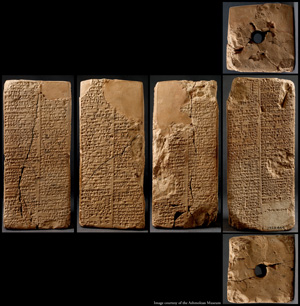introduction to the Ashmolean Museum collections of tablets and inscribed objects
Outside the British Museum, the collection of ancient Near Eastern inscriptions and objects in the Ashmolean Museum, University of Oxford, is the largest and the most representative of its kind in the United Kingdom. Its value is further increased by the presence of the Bodleian Library’s collection of cuneiform tablets. The Ashmolean collection includes tablets allocated to the Museum after excavations by the Oxford-Field Museum Expedition to Kish, Iraq (1923-1933). They constitute the largest provenienced group within the collection. In addition, there are gifts and purchases of tablets, usually without reliable information on their original source.
Stephen Langdon (Shillito Reader 1911-1937) did more than any other single person to develop the tablet collection. Langdon enjoyed the patronage of Herbert Weld-Blundell, who had traveled widely in Africa and the Middle East, and led an expedition to Persepolis in the late 19th Century. He presented his collection to the University in 1921-1922, and subsequently supported the Oxford-Field Museum Expedition to Kish, which Langdon directed. Langdon’s enduring legacy was the Oxford Editions of Cuneiform Texts (OECT) founded in 1923, in the first instance to publish the Weld-Blundell Collection in volumes 1-3, the latter undertaken by Godfrey Driver. OECT 2 presented what subsequently became known as the “Weld-Blundell prism,” featuring a well-preserved version of the Sumerian King List.

The Weld-Blundell prism
Reginald Campbell Thompson’s brief tenure as Shillito Reader (1937-1941) coincided with the evacuation of the Ashmolean Museum collections during the Second World War. Professor Oliver Gurney (Shillito Reader 1945-1978) devoted much attention to the Ashmolean's tablet collection. He joined broken tablet fragments from Kish, and prepared a card index of the whole collection to encourage specialist scholars to research and publish the inscribed material in the Ashmolean Museum. He contributed many copies and identifications of lexical texts to a fundamental publication, Materials for the Sumerian Lexicon. A volume on Sumerian Literary texts by Oliver Gurney and Samuel Kramer was published as OECT 5 in 1976, followed by Dr Gilbert McEwan’s publication of Hellenistic texts in OECT 9 (1982) and Late Babylonian texts in OECT 10 (1984). Professor Gurney published the literary texts with the addition of some non-literary ones in OECT 11 (1989). Dr. Francis Joannès copied the neo-Babylonian texts in the Bodleian Library collection, published as OECT 12 (1990).
Dr Stephanie Dalley taught Akkadian and Sumerian at the University of Oxford from 1979-2007, receiving the title Shillito Senior Research Fellow in 1988. Dr Dalley and Professor Norman Yoffee prepared a volume of Old Babylonian texts, primarily from Kish, also identifying an important group of texts from the Diyala region in the Museum’s collection, published as OECT 13 (1991). Dr Dalley presented further Old Babylonian texts from Larsa, Sippir, Kish and Lagaba in OECT 15, with some copies contributed by Eleanor Robson and Tina Breckwoldt (2005).
Although OECT is the main publication series for the inscribed material in the Ashmolean Museum, Eleanor Robson’s published study of Mesopotamian mathematics, 2100-1600 BC (OECT 14, 1999), mostly drew on sources from other collections, but included some copies of Ashmolean tablets eventually published in OECT 15.
Some studies of the Ashmolean collections have been published elsewhere. An important piece of work was Prof. Ignace Gelb’s Sargonic Texts in the Ashmolean Museum, Oxford (Chicago, 1970). For well over twenty years, Dr. Jean-Pierre Grégoire worked on the Sumerian administrative texts in the collection, resulting in the publication of AAICAB 1/1-4 (2000-2002). This followed his previous republication of the tablets from Jemdet Nasr in the Museum with Robert K. Englund (MSVO 1; Berlin, 1991).
The publication of the collections is now largely complete, although it is hoped that a continuing appraisal of the collections and the digitization of the archive will identify previously unpublished texts, and stimulate new readings and interpretations. The collections continue to be an important resource for specialist researchers, and are frequently used for teaching purposes by staff of the Oriental Institute, University of Oxford. Over the years, the curatorial staff and conservation laboratories of the Department of Antiquities, and the Photographic Studio of the Museum, as well as the staff of the Ashmolean Library and the Griffith Institute have contributed their specialist assistance in various ways. The digital age has now ushered in opportunities for wider dissemination of the Ashmolean collections. With the assistance of Dr. Jacob Dahl and Nathanael Shelley (on behalf of CDLI), digitisation of the Ashmolean tablet collections has been initiated and is a continuing process.
Text based on Roger Moorey’s preface in AAICAB 1 (2000), with additions by Jack Green and Stephanie Dalley.
| Link | https://www.ashmolean.org/ancient-near-east-0 |
|---|---|
| Related artifacts | 6953 artifacts |
| Name | Language |
|---|---|
| Ashmolean Museum | en |
| 阿什莫林博物館 | zh |
| Museu Ashmolean | pt |
| Amgueddfa'r Ashmolean | cy |
| Resource | Link |
|---|---|
| English Wikipedia | Ashmolean_Museum |
The digitized images of photographs and original tablets presented in the joint database of the Ashmolean Museum of Art and Archaeology, Oxford, UK, and the Cuneiform Digital Library Initiative, Los Angeles/Berlin, are for the personal, non-profit use of students, scholars, and the public. All such images are subject to copyright laws and are the exclusive property of the Ashmolean Museum of Art and Archaeology. Commercial use or publication of these images is strictly prohibited without prior written permission from the Ashmolean Museum.
Individual photos can be owned and licensed differently. Always verify the attributes of the digital asset you are interested in.
| Owner | Ashmolean Museum, University of Oxford |
|---|---|
| License |
Coordinates: -1.26007, 51.7554
| Country | United Kingdom GBR |
|---|---|
| Region | England GBR.1_1 |
| District | Oxfordshire GBR.1.69_1 |